WHAT'S NEW ACROSS THE WORLD
What's
new April 2000
What's
new July 2000
What's
new October 2000
What's
new January 2001
What's
new April 2001
What's
new July 2001
What's
new October 2001
What's
new January 2002
What's
new April 2002
What's
new July 2002
| What's New ©by
Laif DeMason
Autumn has just begun and with it arrives
a cooler breeze. Though an economic slowdown has continued for the last
few months, the stay-at-home philosophy of a recession has yet to take
hold in the cichlid trade. Supplies are strong for the most part with certain
sectors of cichlids showing increased interests from buyers. Competition
among collectors, exporters, and breeders is now keen — all of which leads
to the best pricing and availability in some time. No need for low interest
rates; just go shopping!
Here’s “what’s new” on the cichlid scene: |
Lake Tanganyika
Exports from Burundi, Tanzania, and Zambia continue per normal. Collecting
along the southern coast of Congo is now possible but at a high price.
These types of “entry fees” are spreading to other areas causing increased
concern. There is a lesson to be learned here and maybe another reason
why prices may yet go up!
|
what's new: Lake Tanganyika
|

Collected at several places in eastern Zambia, Cyathopharnyx
furcifer “green” is frequently exported. Photo by T. Koziol. |

Exhibiting brilliant hues of blue and yellow, Cyprichromis
leptosoma from Karilani Island (Tanzania) are noteworthy. Photo by
T. Koziol. |
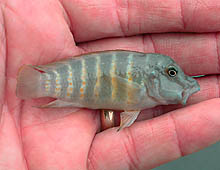
Collected from Cape Bangwe (Tanzania) south of Kigoma,
this variety of Eretmodus cyanostictus is a new arrival. |
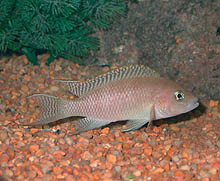
Known in the early 1980s as “Lamp. Walteri”, Neolamprologus
falcicula Kigoma is a smaller princess-type. |
Lake Malawi
Exports from Malawi have struggled to adjust to new shipping routes
and internal logistics. Tanzanian exports seem to have their own problems
as well, but agents from both are still sending out consignments. Mozambique
survives as a hit or miss affair. Bred items remain the “bread and butter”of
African stocks, coming from a variety of farmed sources.

Developed years ago but recently refined for color,
the albino flavescent (Aulonocara) peacock is a real beauty. |

A larger mbuna, Pseudotropheus williamsi “red
top” from Nakantenga Island (Malawi) is infrequently available. Photo by
A. Konings. |

Sold and written about under several names (e.g.,
sp. “slim”; sp. “compact”; zebra OB elongate), this fish is one of the
best OB species for a consistent “blueberry” pattern. Originally from Mbamba
Island (Tanzania), its lack of popularity may simply be due to its lack
of a good trade name! |

Large import facilities for cichlids usually receive
several oddball items that arrive as contaminants. Here Corematodus
taeniatus, a scale-eater from Tanzania, which becomes a beautiful emerald
green not often seen in Malawian haplochromines. |
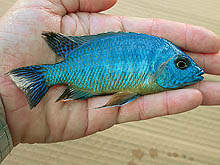
A classic “steveni” from Cape Kaiser (Tanzania), this
fish exhibits the typical blue-gold coloration and lean body form. |
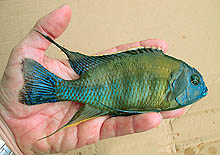
Often sold as “imperial steveni”, this incredibly
beautiful Protomelas species from Tanzania is more closely related
to P. taeniolatus types, such as “red empress” and “fireblue.” |
Victoria
Unfortunately, there is only bad news to report for Victorian cichlid
fans. Increasingly, as novice hobbyists join the ranks, more misidentified
and hybridized cichlids are being passed off as established species. People
just do not have enough reference material at hand. The aquarium literature
available is just not adequate for the mainstream Victorian buff.

An “old timer” from the 1980s or before, Astatoreochromis
alluaudi is still found from specialized breeders. |
 Many wild-caught cichlids, such as this predator haplochromine from Lake
Nawapasa (Uganda), were just imported once, never to become established
before the long export embargo began. Photo by M. Smith.
Many wild-caught cichlids, such as this predator haplochromine from Lake
Nawapasa (Uganda), were just imported once, never to become established
before the long export embargo began. Photo by M. Smith. |
Neotropics
Rains have abated in South America, and thus the collecting season has
begun again. Recent news that the government in Peru has restricted several
fish species from export has spread confusion of late. Other bred varieties
still abound, even if you have to look a little more for some of the rarely
bred ones!

Originally from Rio Itapicuru, Brazil, Geophagus
itapicuruensis are available from eartheater specialists. Photo by
J. Rapps. |
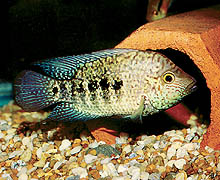
For Middle American fans, Herichthys sp. “Altamira”
originally hails from the gulf coast of Mexico. Photo by J. Rapps. |
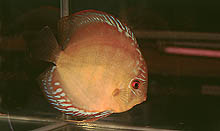
Bred in the Far East and selected for the basic colors
and form of the “brown” discus is this strain of Symphysodon discus. |
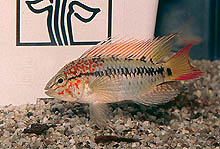
Often bred in central Europe in good numbers, Apistogramma
viejita II exhibits excellent red markings. |
|











 Many wild-caught cichlids, such as this predator haplochromine from Lake
Nawapasa (Uganda), were just imported once, never to become established
before the long export embargo began. Photo by M. Smith.
Many wild-caught cichlids, such as this predator haplochromine from Lake
Nawapasa (Uganda), were just imported once, never to become established
before the long export embargo began. Photo by M. Smith.


